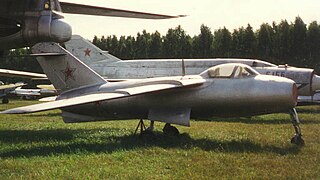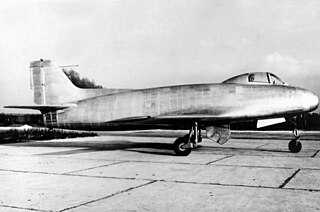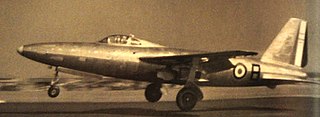
The Lavochkin La-15, was an early Soviet jet fighter and a contemporary of the Mikoyan-Gurevich MiG-15 which was in service with the Soviet Air Force from 1949 till 1953.

The Sukhoi Su-9 was an early jet fighter built in the Soviet Union shortly after World War II. The design began in 1944 and was intended to use Soviet-designed turbojet engines. The design was heavily influenced by captured German jet fighters and it was subsequently redesigned to use a Soviet copy of a German turbojet. The Su-9 was slower than competing Soviet aircraft and it was cancelled as a result. A modified version with different engines and a revised wing became the Su-11, but this did not enter production either. The Su-13 was a proposal to re-engine the aircraft with Soviet copies of the Rolls-Royce Derwent turbojet as well as to modify it for night fighting, but neither proposal was accepted.

The Yakovlev Yak-19 was a prototype Soviet fighter built in the late 1940s. It was the first Soviet aircraft to be equipped with an afterburning turbojet, the Klimov RD-10F that was derived from the German Jumo 004 engine. Only two examples were built as it was rejected for service by the Soviet Air Force.

The Bréguet Br 960 Vultur was a prototype two-seat carrier-based attack and anti-submarine aircraft (ASW) built for the French Navy during the early 1950s. Meeting contradictory endurance and speed requirements, it was designed as a "mixed-power" aircraft with a turboprop engine in the front and a turbojet in the rear. Only two examples were built, but the second aircraft was rebuilt as the prototype of the Bréguet 1050 Alizé ASW aircraft after the Navy dropped the idea of a turboprop attack aircraft in the mid-1950s.

The Nord 1500 Griffon is an experimental ramjet-powered interceptor aircraft designed and built by French state-owned aircraft manufacturer Nord Aviation. The Griffon was developed to become a Mach 2 follow on to the supersonic Nord Gerfaut research aircraft. Development of the aircraft began in earnest after the receipt of a letter of intent in 1953 for a pair of unarmed research aircraft. The design featured an innovative dual propulsion turbojet-ramjet configuration; the former being used to takeoff and attain sufficient speed to start the latter.

The SNCAC NC 1080 was a French jet-engined interceptor developed in the late 1940s by SNCAC for use aboard aircraft carriers. It was intended to compete for an Aéronavale contract and first flew in 1949. The aircraft used an innovative system of flight control surfaces that proved to be a failure during flight testing and had to be modified before it could fly again. Its development was troubled by other design flaws and the company's merger with SNCAN that same year. Further development was cancelled after a fatal crash destroyed the sole prototype in 1950.

The Leduc 0.10 is a research aircraft built in France, one of the world's first aircraft to fly powered solely by a ramjet.

The Arsenal VG 90 was a French carrier-based jet-engined interceptor developed in the late 1940s. It was intended to compete for an Aéronavale contract and first flew in 1949. It set a speed record for a French aircraft the following year, but both of the completed prototypes were destroyed in fatal crashes and the program was cancelled in 1952 before the third prototype was finished. The Aéronavale contract was eventually awarded to a license-built British aircraft. The remains of the last VG 90 were scrapped in 1978.

The Sud-Ouest SO.6000 Triton is an early experimental French jet aircraft. It has the distinction of being the first indigenously-designed jet-powered aircraft to be flown by the nation, having been designed and manufactured during the 1940s by the French aircraft construction consortium SNCASO.
The Focke-Wulf Project I was a design study for a jet fighter, to be built in Germany during World War II. In 1942, the Reichsluftministerium (RLM) asked Professor Kurt Tank of the Focke-Wulf factory to investigate the possibility of a single-engine jet fighter. He was given the development plans of the BMW 003, Jumo 004 and Heinkel HeS 011 engines. Late in 1942 the Project Office, led by Ludwig Mittelhuber, began to work on a series of fighter projects, to be powered by one of these new turbojet units.

The EFW N-20 Aiguillon was Switzerland's first indigenous jet fighter project. The Swiss Federal Aircraft Factory developed a design for a four-engined swept winged fighter following the end of the Second World War. An unpowered sub-scale N-20.01 glider and a turbojet powered test aircraft, also sub-scale and known as the N-20.02 Arbalète ("Crossbow"), were test flown. A fighter prototype N-20.10 Aiguillon was built but never flown, and a twin-engines N.20.20 Harpon was also proposed but not followed up.

The Nord 1601 was a French aerodynamic research aircraft designed and built by Nord Aviation. The aircraft was designed to investigate the aerodynamics of swept wings and related high-lift devices.

The Nord Gerfaut (Gyrfalcon) was a French delta-wing experimental research aircraft. It was the first European aircraft to exceed Mach 1 in level flight without the use of an afterburner. A pair of aircraft were built for the primary purpose of investigating the transonic regime. The Gerfaut I conducted its maiden flight in 1954; it was followed by the improved Gerfaut II two years later. Both aircraft were flown for several years for experimental purposes, being significantly upgraded over time. During the course of these test flights, the second prototype establishment multiple time-to-altitude world records. In the late 1950s, the type was used to flight-test various aerial missiles. Both aircraft performed their final flights in 1959; they were subsequently used as targets at the Military Test Range at Cazaux.

The Leduc 022 was the prototype of a mixed-power French interceptor built in the mid-1950s. Designer René Leduc had been developing ramjet-powered aircraft since before World War II and had flown a series of experimental aircraft, the Leduc 0.10 and Leduc 0.21, throughout the 1950s before he was awarded a contract for two examples of a short-range supersonic interceptor armed with two air-to-air missiles (AAMs).

The Alekseyev I-21 was a Soviet twin-engined jet fighter, built in the late 1940s. Two prototypes were constructed with the designation of I-211, of which one was converted into the I-215 with more powerful engines. A third aircraft was built to evaluate the bicycle landing gear arrangement for use in other aircraft. The fighter was not accepted for production as it was inferior to the swept-wing fighters like the Mikoyan-Gurevich MiG-15.

The Nord 2200 was a French carrier-based, jet-engined interceptor developed in the late 1940s. It was intended to compete for an Aéronavale contract, but was not selected for production after a 1950 accident badly damaged the sole prototype. It was repaired and resumed flight testing the following year, which including evaluating rocket-assisted take offs. After the aircraft made its last flight in 1954, it was used as a gunnery target. Much of the airframe was recovered in the 1980s, but its current disposition is uncertain.

The SNCASO SO.9000 Trident is a French jet and rocket powered interceptor aircraft built by aircraft manufacturer SNCASO during the 1950s. As part of a wider effort to re-build French military power during the late 1940s and to furnish France with advanced, new domestically produced designs, a request for a supersonic-capable point-defence interceptor aircraft to equip the French Air Force was issued to SNCASO. In response, the firm designed the mixed-propulsion Trident, powered by a single SEPR rocket engine, which was augmented by wingtip-mounted turbojet engines, and the Air Force ordered two prototypes.

The SNCASE Grognard was designed as a single-seat, low-level ground-attack aircraft. Although in development in the 1950s for the French Armée de l'Air, the program was cancelled in favor of the Sud-Ouest Vautour II.

The SNCASO SO.8000 Narval was a French carrier-based strike fighter designed by Sud-Ouest in the late 1940s. The French Navy ordered two prototypes in 1946 and they made their maiden flights three years later. They were plagued by aerodynamic problems and unreliability issues with their piston engines. The aircraft proved to be slow, lacking in lateral and longitudinal stability and unsuitable for carrier operations; it did not enter production.

The Sud-Ouest SO.6020 Espadon (Swordfish) was a French post-war prototype interceptor designed and built by SNCASO during the late 1940s. The French Air Force judged the design a failure despite some records being set and cancelled plans to put it into service in 1951. Only four aircraft were built and they were later modified to serve as testbeds for the mixed rocket and turbojet-powered SNCASO SO.9000 Trident program. Only one badly damaged aircraft survives.




















